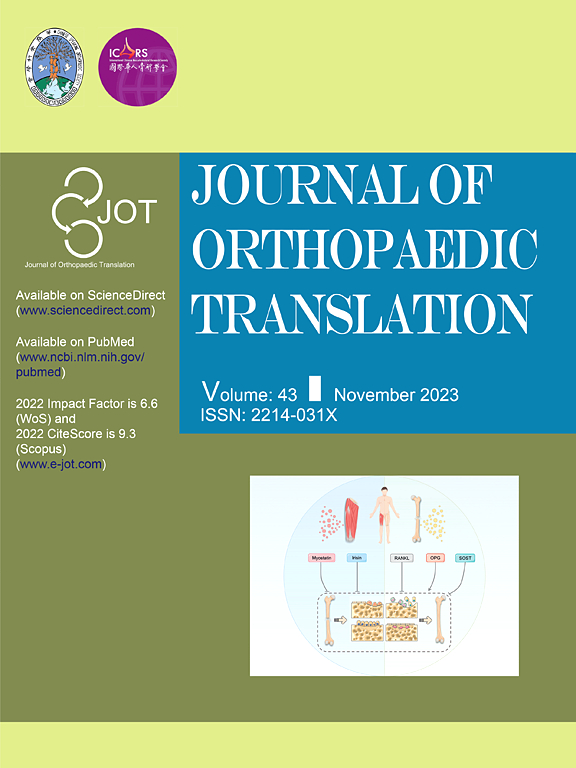PDGF-BB通过恢复兔类固醇相关性骨坏死的成骨微环境改善皮质骨质量
IF 5.9
1区 医学
Q1 ORTHOPEDICS
引用次数: 0
摘要
目的类类固醇相关性股骨头坏死(SONFH)是一种以进行性骨破坏为特征的顽固性疾病。临床证据表明,SONFH可能会扩展到股骨头内区以外的股骨颈、干骺端甚至骨干,增加股骨粗隆下骨折和术后植入物松动的风险。虽然我们之前的研究表明血小板衍生生长因子- bb (PDGF-BB)促进股骨头的修复性成骨,但其对类固醇相关性骨坏死(SAON)下延伸骨干区皮质骨质量的影响尚不清楚。本研究旨在探讨PDGF-BB是否可以减轻SAON进展期间股骨骨干皮质骨退化。方法采用重复注射脂多糖(LPS)和甲基强的松龙(MPS)诱导家兔saon。在SAON诱导后2、4和6周,将PDGF-BB髓内注射到股骨近端。在安乐死前第14天和第4天分别皮下注射二甲酚橙和钙黄素绿。在最后一次PDGF-BB治疗后3天,进行微膜灌注血管造影。然后解剖股骨干,进行微计算机断层扫描(μCT)血管造影、μCT皮质骨几何和组织学分析。针对SAON进展过程中骨坏死区巨噬细胞浸润和破骨细胞活化功能,利用RAW 264.7细胞体外评价PDGF-BB对巨噬细胞极化和破骨细胞活性的影响。结果在本研究中,在saon诱导后6周,骨坏死扩展到股骨干,伴有血管破坏(CD31+血管减少)、感觉神经变性(CGRP +纤维减少)和皮质骨破坏。而PDGF-BB治疗可显著减轻股骨干SAON的进展,恢复血液供应(血管造影)并改善皮质骨几何形状(μCT)。组织学上,PDGF-BB增强骨膜和骨膜内成骨,同时抑制破骨细胞吸收。在体外,PDGF-BB不仅可以调节m1型巨噬细胞的极化,减轻炎症反应,还可以在破骨细胞形成过程中提供二次生物活性因子来源,恢复成骨微环境,提示其具有解决炎症和促进骨重塑的双重作用。结论SAON进展导致干骺端皮质骨退化,而PDGF-BB在SAON进展过程中可恢复成骨微环境,促进皮质骨重塑。这些发现表明PDGF-BB可能作为减缓SAON进展的潜在候选物。在SONFH手术干预期间局部输送PDGF-BB可能会增强皮质骨修复并提高机械稳定性,为实现更好的长期预后提供临床可行的策略。本文章由计算机程序翻译,如有差异,请以英文原文为准。

PDGF-BB improves cortical bone quality through restoring the osteogenic microenvironment in the steroid-associated osteonecrosis of rabbits
Objective
Steroid-associated osteonecrosis of the femoral head (SONFH) is a refractory disease characterized by progressive bone destruction. Clinical evidence suggests that SONFH may extend beyond the intra-capital region to the femoral neck, metaphysis, and even diaphysis, increasing the risk of subtrochanteric fractures and implant loosening post-surgery. While our previous study demonstrated that platelet-derived growth factor-BB (PDGF-BB) promotes reparative osteogenesis in the femoral head, its effects on cortical bone quality in the extended diaphyseal regions under steroid-associated osteonecrosis (SAON) remain unclear. This study aims to investigate whether PDGF-BB could mitigate cortical bone deterioration in the femoral diaphysis during SAON progression.
Methods
SAON was induced by repeated lipopolysaccharide (LPS) and methylprednisolone (MPS) injections in rabbits. At 2, 4, and 6 weeks after SAON induction, PDGF-BB was intramedullary injected into the proximal femur. Xylenol orange and Calcein green were injected subcutaneously into rabbits on days 14 and 4 before euthanasia. At 3 days after last PDGF-BB treatment, micro-fil perfusion was performed for angiography. Then the femur shaft was dissected for micro-computed tomography (μCT)-based angiography, μCT-based cortical bone geometry, and histological analysis. With regard to the macrophage infiltration and activated osteoclast function in osteonecrosis regions during SAON progression, RAW 264.7 cells were utilized to evaluate the effect of PDGF-BB on macrophage polarization and osteoclasts activity in vitro.
Results
In this study, osteonecrosis extended to the femoral diaphysis, accompanied by vascular disruption (reduced CD31+ vessels), sensory nerve degeneration (decreased CGRP + fibers), and cortical bone destruction, at 6 weeks post-SAON induction. While PDGF-BB treatment significantly attenuated SAON progression in the femoral diaphysis, restoring blood supply (angiography) and improving cortical bone geometry (μCT). Histologically, PDGF-BB enhanced periosteal and endosteal osteogenesis while suppressing osteoclastic resorption. In vitro, PDGF-BB not only could modulate M1-type macrophages polarization to reduce inflammatory response, but also subsequently afford a secondary source of bioactivity factors during osteoclasts formation process to restore the osteogenic microenvironment, suggesting a dual role in resolving inflammation and enhancing bone remodeling.
Conclusion
SAON progression leads to diaphyseal cortical bone deterioration, while PDGF-BB application could restore the osteogenic microenvironment and drive cortical bone remodeling during SAON progression.
The translational potential of this article
These findings suggest that PDGF-BB could serve as a potential candidate for attenuating the progression of SAON. Local delivery of PDGF-BB during surgical interventions for SONFH may enhance cortical bone repair and improve mechanical stability, offering a clinically viable strategy to achieve better long-term outcomes.
求助全文
通过发布文献求助,成功后即可免费获取论文全文。
去求助
来源期刊

Journal of Orthopaedic Translation
Medicine-Orthopedics and Sports Medicine
CiteScore
11.80
自引率
13.60%
发文量
91
审稿时长
29 days
期刊介绍:
The Journal of Orthopaedic Translation (JOT) is the official peer-reviewed, open access journal of the Chinese Speaking Orthopaedic Society (CSOS) and the International Chinese Musculoskeletal Research Society (ICMRS). It is published quarterly, in January, April, July and October, by Elsevier.
 求助内容:
求助内容: 应助结果提醒方式:
应助结果提醒方式:


